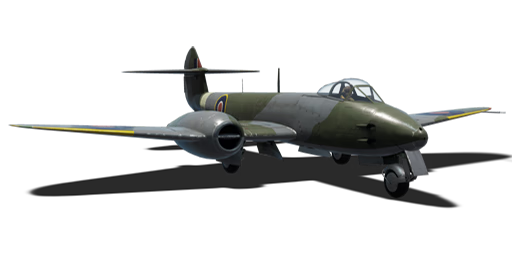



The Gloster Meteor was the first and only Allied jet aircraft to see combat in WWII. Beginning development in 1940, prototypes first flew in 1943, and the first production variant soon entered service in July 1944. They were initially used to intercept V-1 flying bombs, achieving the world's first air-to-air "kills" in a jet-powered fighter on 4 August, just a few days before its German competitor, the Me 262, achieved the same on a piloted aircraft. The Meteor F Mk 3, equipped with improved Rolls-Royce Derwent I engines, would enter service in December 1944. They were deployed in Europe, providing air defence over Belgium and the Netherlands, having initially been banned from flying over the continent for fears of being downed and captured by the Germans or Soviets. The Meteor would spawn a number of variants, and would remain in operational service as late as 1970 with export customers such as Argentina.
In the game since the start of the Open Beta Test prior to Update 1.27, the Meteor F Mk 3 is a solid jack-of-all-trades, and an excellent introduction to early jet combat. While not as fast as the Attacker, nor as manoeuvrable as the Vampire, the Meteor provides a balanced and versatile platform capable of dogfighting common opponents and adapting to any situation. Its nonetheless excellent manoeuvrability allows it to easily bait and trap most opponents in a turnfight, while the four venerable Hispano cannons mounted in the nose will quickly down any target once on their tail. Its main drawbacks include the somewhat low engine power, as one might expect from one of the first of their kind, as well as the rather stiff roll rate; both issues become greatly alleviated in future variants.
flaps
flaps
flaps
brake
| Belt | Belt filling | Armor penetration (mm) at a distance: | |||||
|---|---|---|---|---|---|---|---|
| 10 m | 100 m | 500 m | 1000 m | 1500 m | 2000 m | ||
| HEI/SAP-I/T | 22 | 20 | 14 | 9 | 6 | 4 | |
| AP-T/HEI/SAP-I | 37 | 35 | 25 | 16 | 10 | 7 | |
| T/HEI/SAP-I/HEI/SAP-I | 22 | 20 | 14 | 9 | 6 | 4 | |
| AP-T/T/HEI | 37 | 35 | 25 | 16 | 10 | 7 | |
| AP-T/SAP-I/HEI/AP-T | 37 | 35 | 25 | 16 | 10 | 7 | |
| HEI/HEI/SAP-I | 22 | 20 | 14 | 9 | 6 | 4 | |












Flight performance | |
|---|---|
Survivability |
|---|
Weaponry | |
|---|---|